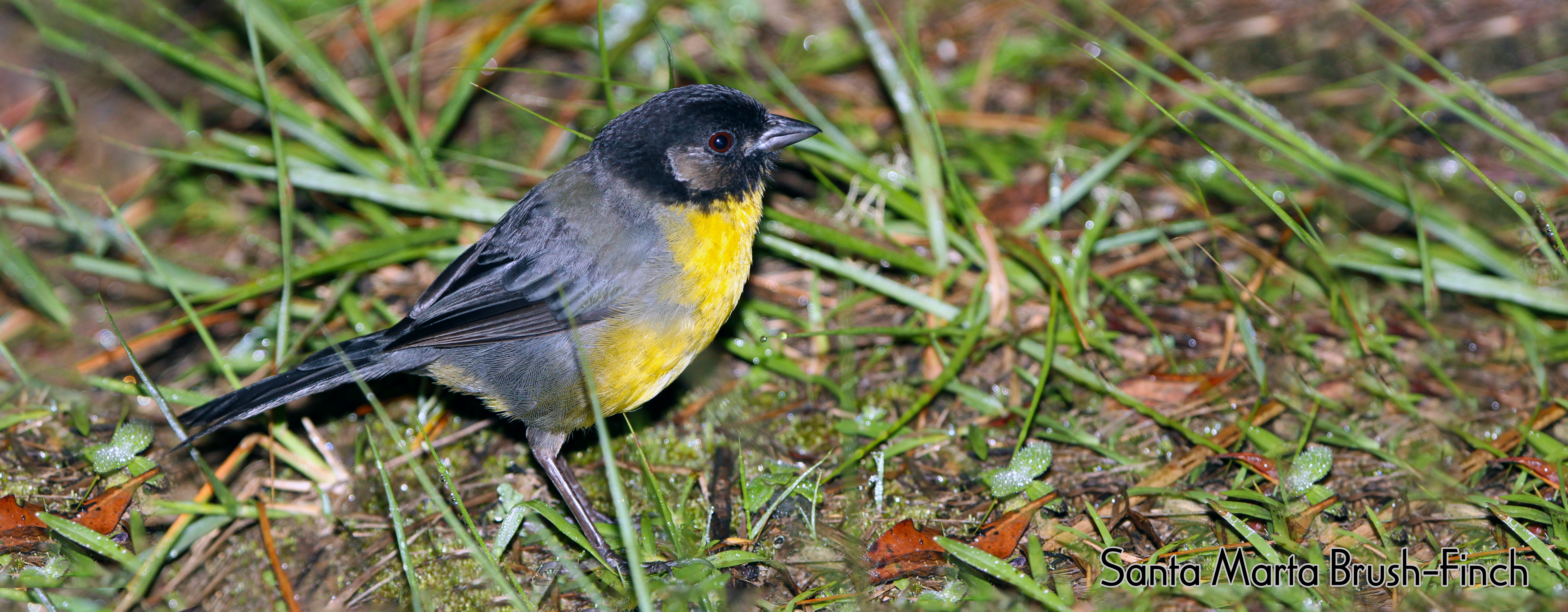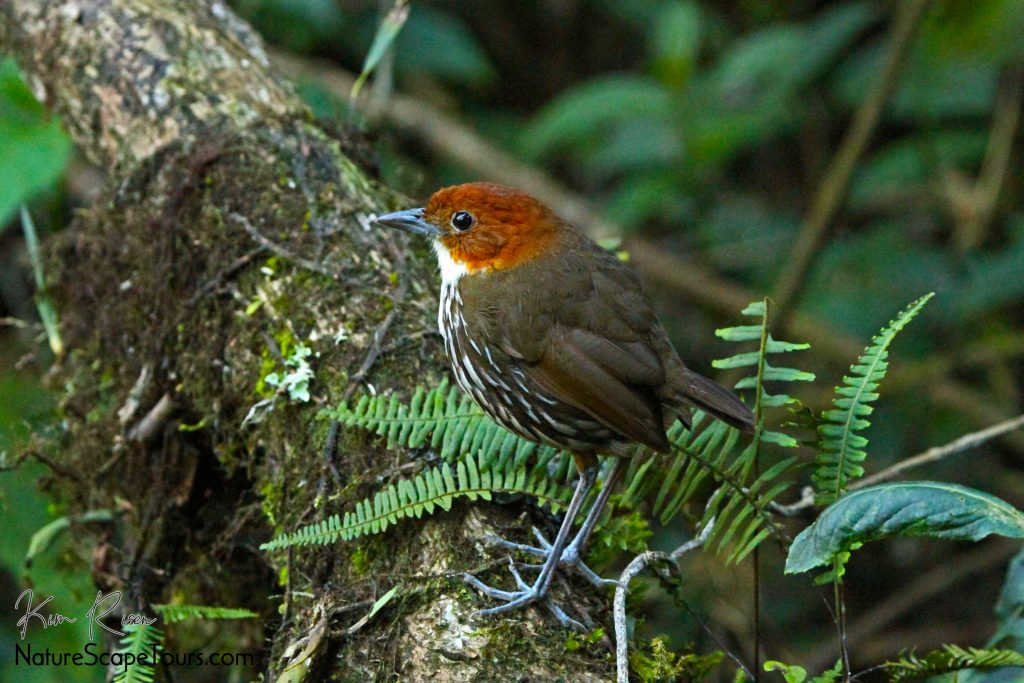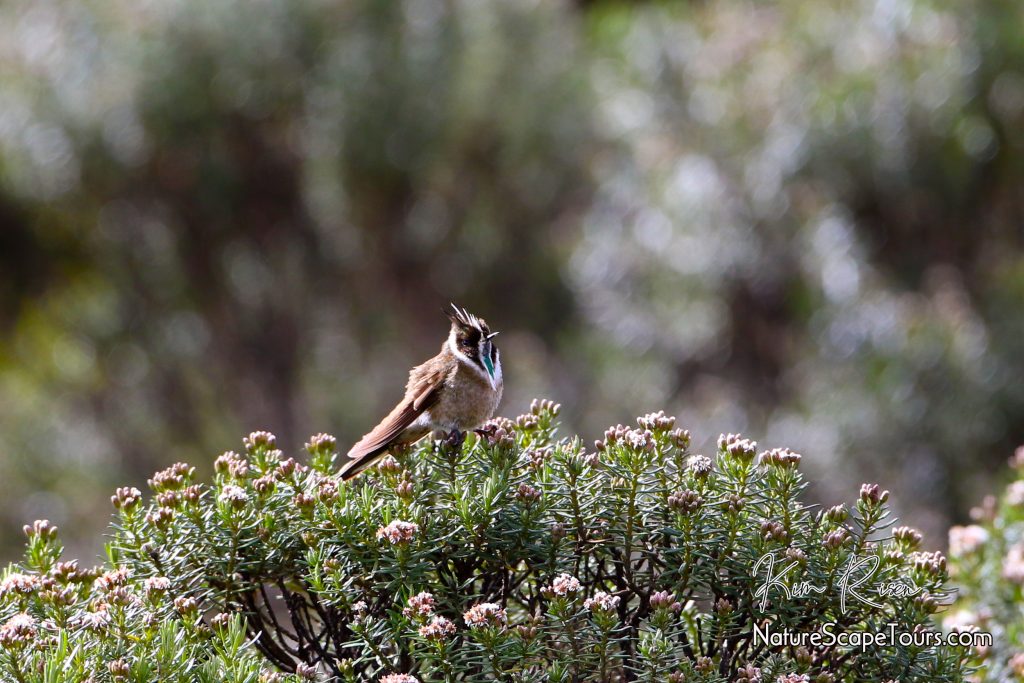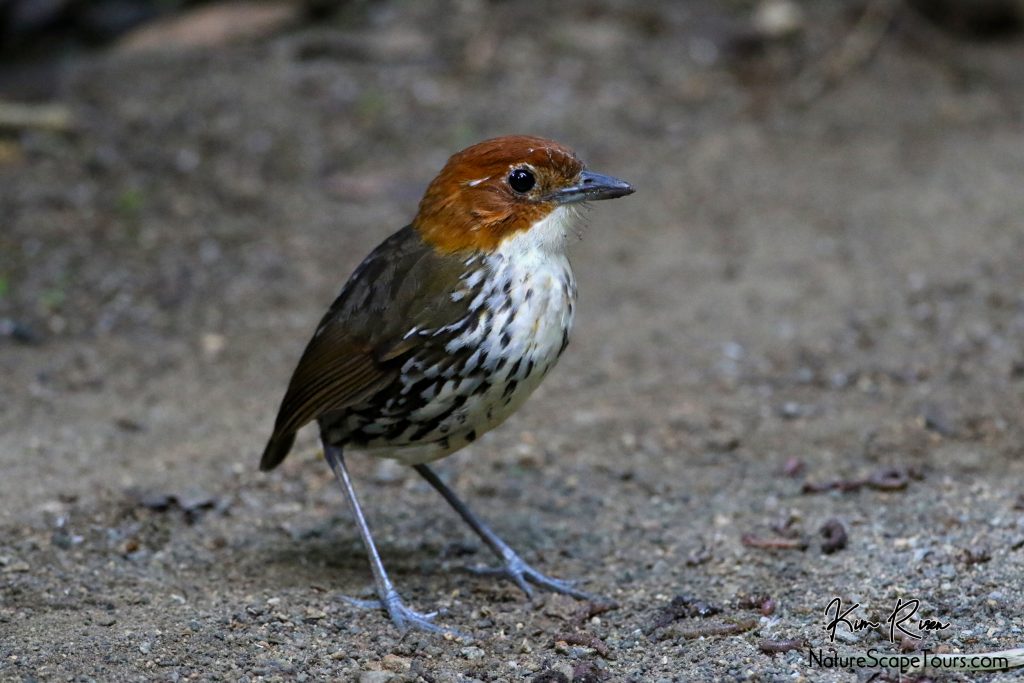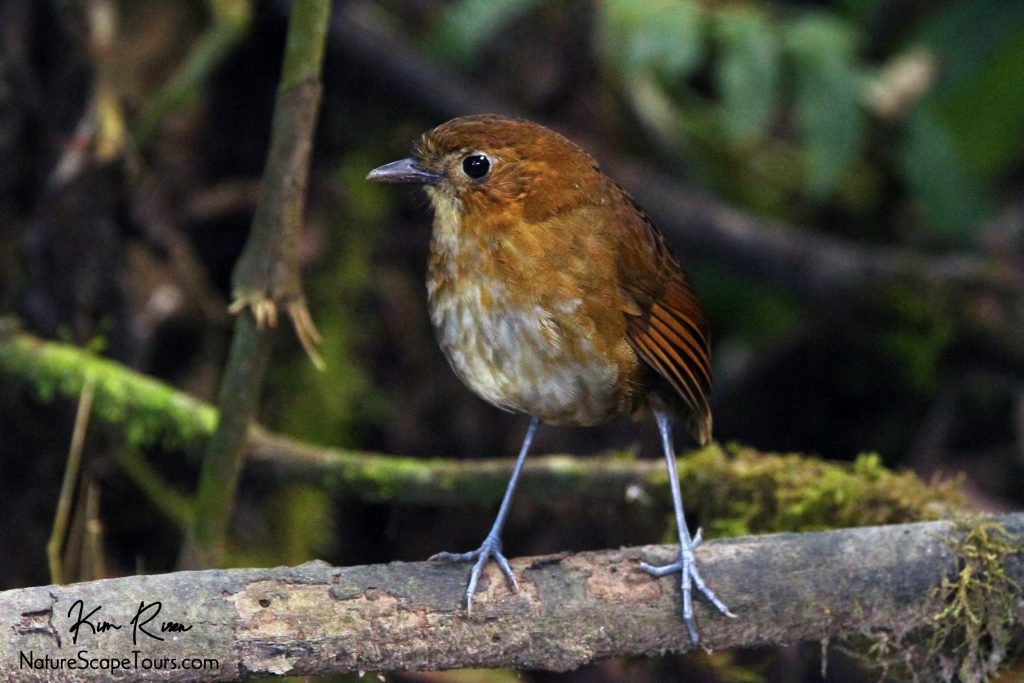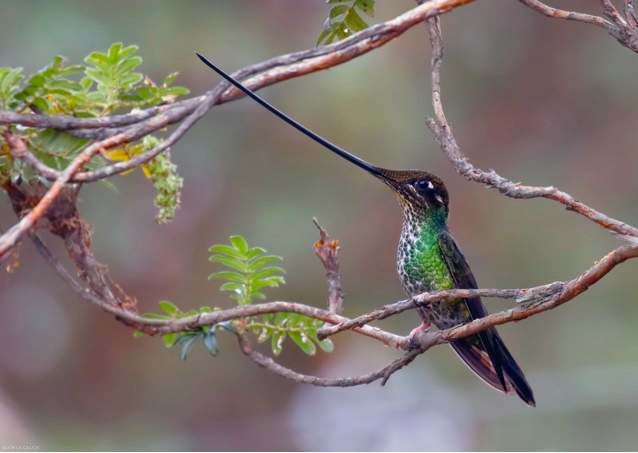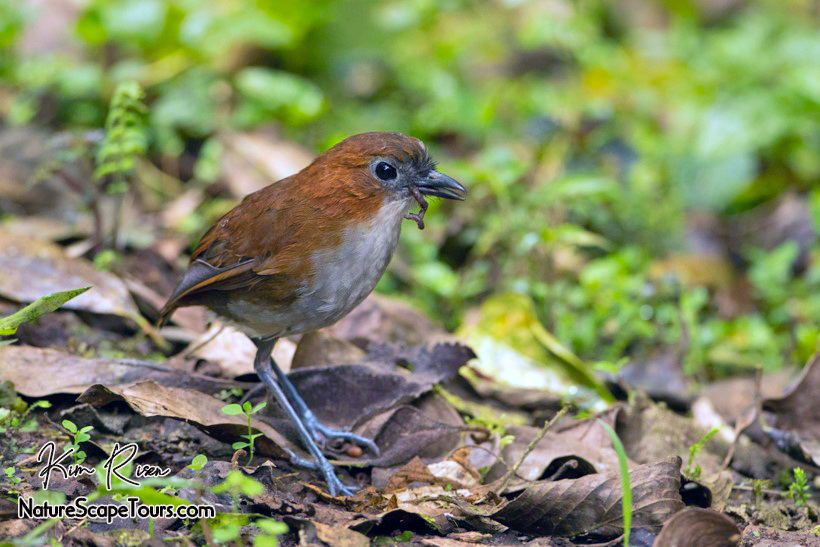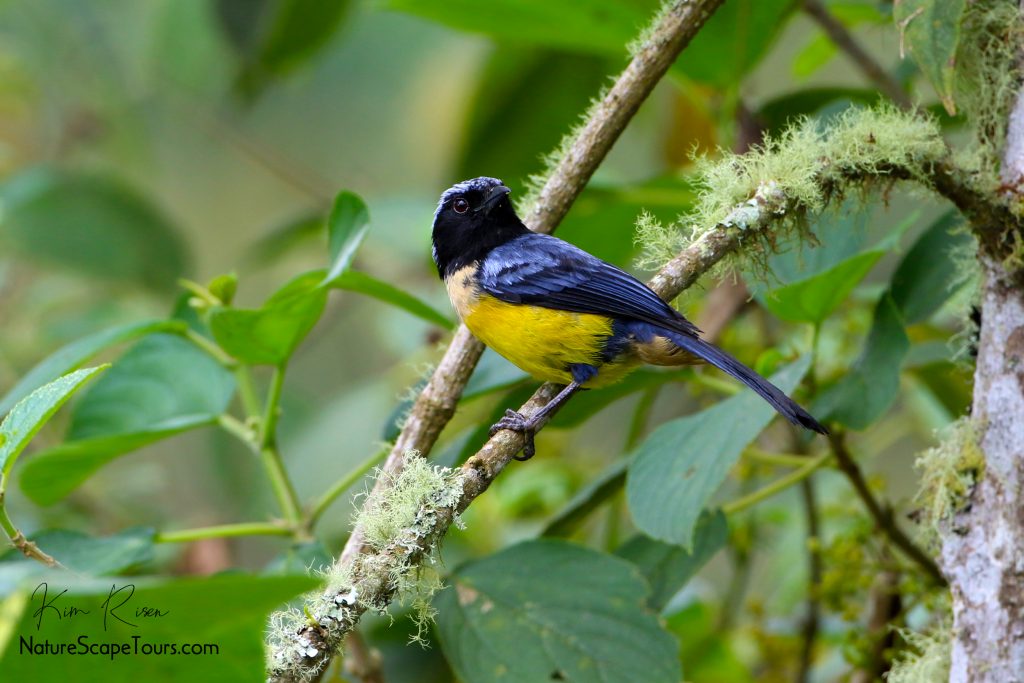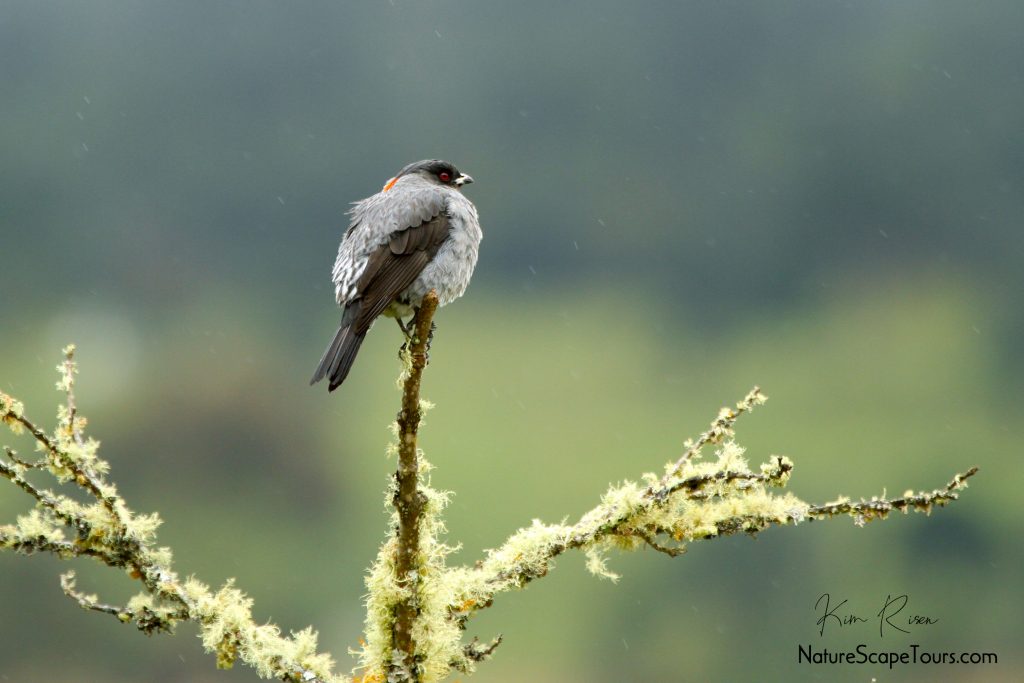COLOMBIA: Central and Western Cordillera and Santa Marta Mountains
| Registration |
Colombia, with its incredibly diverse landscape, is home to more species of birds than any other country on Earth. With almost 2,000 species recorded thus far, you’ll be in awe of the region’s spectacular avifauna as we explore Colombia’s lush cloud forests, wetlands, valleys and high mountain plains on this 15-day adventure. Join NatureScape Tours as we return to one of Earth’s most dynamic birding destinations. While the birding is fantastic, you’ll find the culture, gastronomy and fine people of Colombia have much to offer all who visit.
While the Chocó and Colombia’s Western Andes host a wealth of endemic birds, the region near the towns of Manizales and Pereira should not be underestimated. Diversity is through the roof here, most sites are generally easy to access with accessible, comfortable accommodation. In short, the birding is beyond excellent!
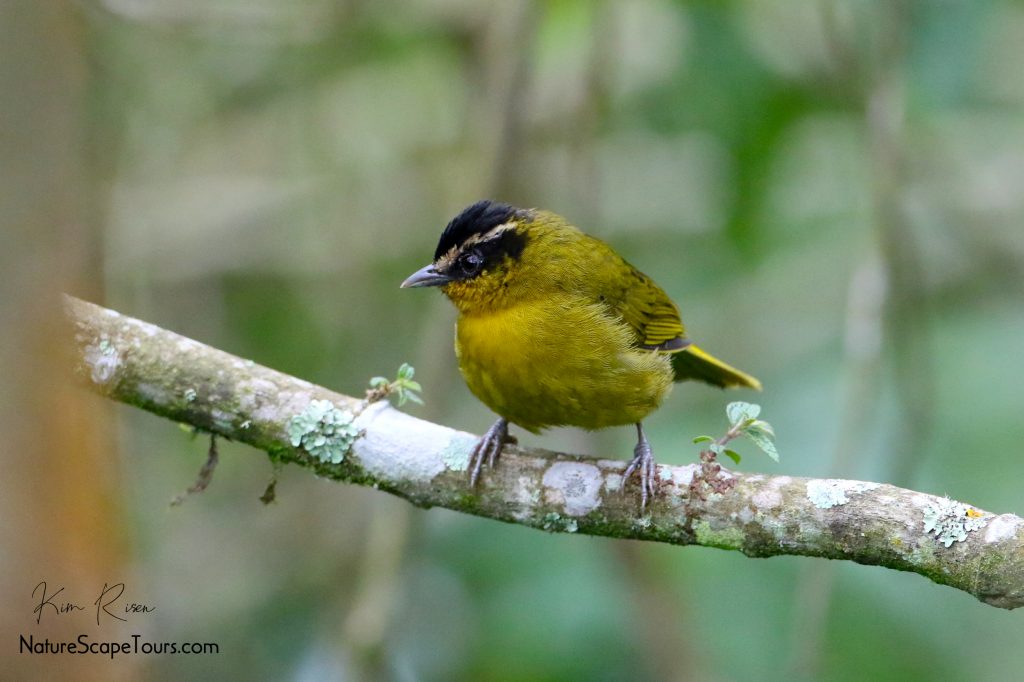
Black-capped Hemispingus is a northern Andes specialty we will search for at the Rio Blanco Reserve.
The cites of Pereira and Manizales sit astride Colombia’s famed Coffee Triangle providing a perfect centralized location from which to visit several reserves holding some of Colombia’s most rare and threatened birds. We’ll use the airport at Pereira as Manizales has far more weather related delays or cancellations compared to the nearby airport at Pereira. On this tour we’ll spend time at three sites, Otun Quimbaya Fauna & Flora Sanctuary, Rio Blanco Reserve and Los Nevados National Park.
Primary among these sites is the Rio Blanco Reserve, one of the best birding sites in Colombia. It’s particularly reliable for shy, skulking species as no fewer than 7 species of antpittas and 5 species of tapaculos can be found here. Owned by Aguas de Manizales (the local water company), the reserve sits along an altitudinal gradient, thus providing the reserve a wide variety of ecosystems within its borders. Birders and bird photographers are sure to be impressed by the “feeders” at the reserve where hummingbirds, tanagers, antpittas and even tapaculos can all be seen at close range.
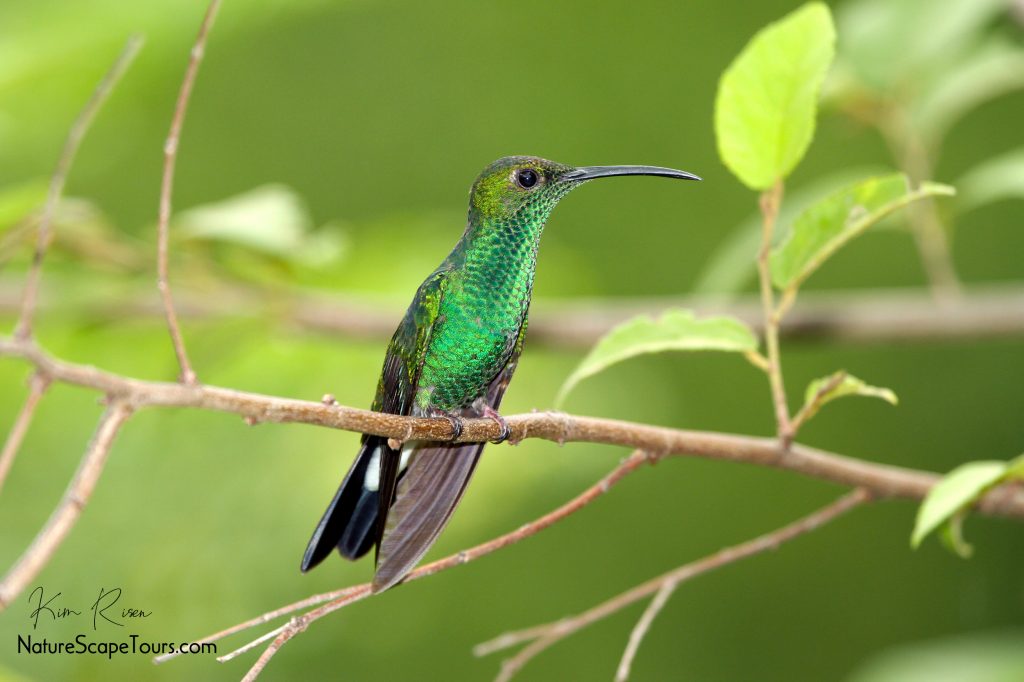
White-vented Plumeleteer is a striking and relatively common resident of the Andes of northwestern South America.
Located in Colombia’s central cordillera, and founded in 1996, Otun Quimbaya consists of reclaimed plantation lands of over 1,200 acres laying between about 5,500 and 7,500 feet in elevation. It offers easy access to a number of important species and is, perhaps, the best place to see and/or photograph gems as Cauca Guan, Chestnut Wood-Quail, Moustached Antpitta, Multicolored Tanager, Crested Ant-Tanager and Red-ruffed Fruitcrow. The latter being uncommonly cooperative at times.
We’ve expanded our visit to the dramatic highlands of Los Nevados National Park to two nights, thus allowing extra time for this special area and for better chances at those species adapted to high elevations. Extensive areas of Paramo grasslands and exotic looking Frailejón plants (properly known as Espeletia, but commonly called “frailejones”, are a genus of perennial shrub-like plants native to higher altitudes of Colombia, Venezuela and Ecuador) provide the work of art while the beautiful backdrop of Nevado del Ruiz overlooks it all.
Visiting a variety of sites around Bogota will allow us to find many species we aren’t likely to find elsewhere during our travels around Colombia. A few of the sites we plan to visit include Chingaza National Park, the Siecha Wetlands, La Florida, Jardin Encantado and Observatorio de Colibries.
Chingaza National Park, situated in Colombia’s Eastern Andes, rises to over 13,000 feet in elevation. Consisting of more than 190,000 acres, we’ll concentrate our efforts in Chingaza’s sub-alpine and paramo grasslands where we aren’t likely to get higher than 11,000 feet. Primary targets include endemic Green-bearded Helmetcrest and Silvery-throated Spinetail and a raft of high altitude specialists. Breathtaking landscapes combine with a series of specialty birds to provide a thoroughly enjoyable high altitude birding adventure!
Jardin Encantado has an impressive display of hummingbird and fruit feeders that attract hundreds of hummingbirds and a smaller selection of tanagers and urban birds. The endemic Indigo-capped Hummingbird and near endemic Red-billed and Short-tailed Emeralds and Scrub Tanager are our principal objectives. However, photography opportunities of several hummingbird species is better here than anywhere else on our itinerary…but bring your short lens, birds are often too close to focus!
Observatorio de Colibries is a quaint, private compound situated at close to 10,000 feet above sea level in the mountains east of Bogota. A dozen or more hummingbird species visit their feeders daily, some species which are difficult to find elsewhere, offering spectacular observation and photographic opportunities. As our group is small, we’re fortunate that we’ll be able to stay at this charming lodge for two nights!
Our trip to Colombia’s northeast brings us to Isla Salamanca National Park, where birding through mangroves and coastal wetlands, along the ocean and in dry scrub forest should yield species as varied as the near endemic Chestnut-winged Chachalaca, Russet-throated Puffbird, Panama Flycatcher and Carib Grackle.
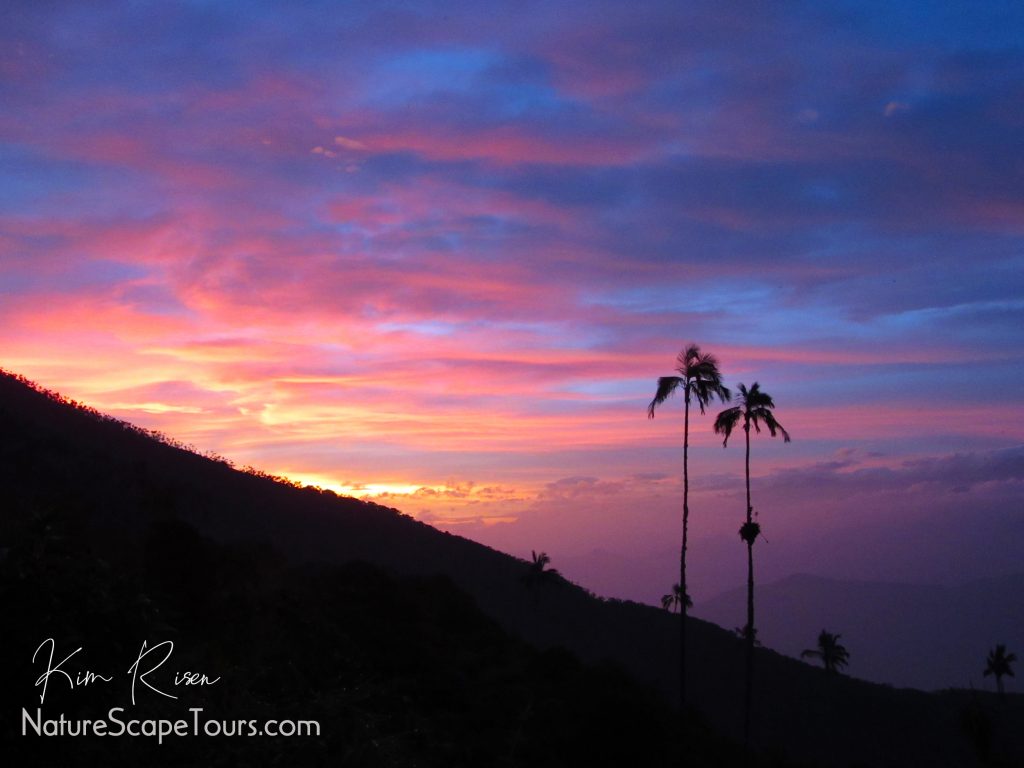
Sunset over the Sierra Nevada de Santa Marta in northern Colombia. This endemic rich mountain range will be our final destination on this tour.
The Sierra Nevada de Santa Marta is the highest coastal mountain in the world. Its lush slopes rise dramatically from the Caribbean Coast becoming isolated from the rest of the Andes by a “sea” of surrounding dry forest. Santa Marta’s snow-capped peaks and ridges are one of the world’s most important centers of endemic birds. They hold about 25% of Colombia’s endemic birds—21-36 species, depending upon your systematic selections—the highest number of endemic birds of any area in Colombia. No fewer than 39 endemic subspecies occur, many of them prime candidates for future splits. We’ll search for as many of these endemics as we can including Santa Marta Screech-Owl, Antpitta, Mountain-Tanager, Tapaculo, Foliage-gleaner, Brushfinch, Parakeet, Sabrewing, Bush-Tyrant, Seedeater, Warbler and a host of others!
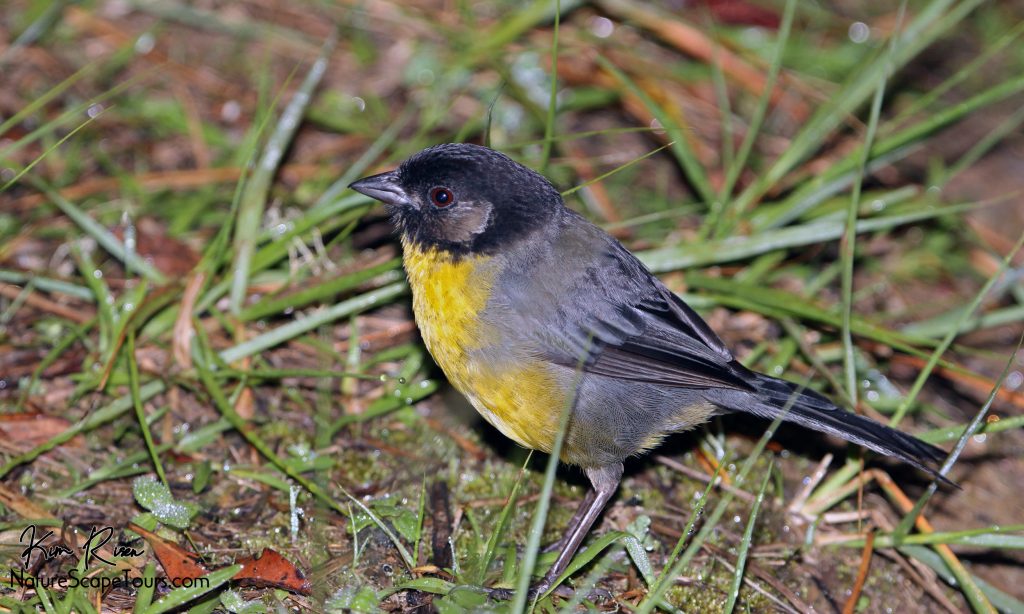
Santa Marta Brush-Finch is one of the numerous endemics of the Santa Marta Mountains of northern Colombia that we should see on this tour.
Join us in Colombia—a beautiful country with friendly residents and unsurpassed diversity of flora and fauna.
Planned Itinerary
Day One – Arrival into Bogota. Group members arrive independently into Bogota. You’ll be met at the airport by your leader, Rick Bowers, as you exit the secured customs & immigration area. After a hectic travel day, we’ll transfer immediately to our hotel for a good night’s rest. Night Bogota.
Day Two – Fly to Pereira, to Otun Quimbaya. After breakfast, we’ll transfer to the airport and our flight to Pereira. Once we’re settled on the ground, it’s only a short distance—less than 15 miles—to our first birding stop, the charming Otun Quimbaya Fauna & Flora Sanctuary. Otun Quimbaya is well-known as the best site for the endemic, endangered and now very local Cauca Guan. You’ll find that birding along the sanctuary’s fairly flat trails and forested roadways is relaxed and easy. Additionally, much of the forest understory is strikingly open, thus more easily navigable, making Otun Quimbaya a great place to actually see antpittas, wood-quail and other forest floor loving species. Reserve specialties include Chestnut Wood-Quail, Red-ruffed Fruitcrow and Cauca Guan, expect to see several each day. Black-and-chestnut Eagle soar overhead and Bronze-winged Parrots fly screechingly across the skyline. Shaded forests shelter Scaled, Moustached and Chestnut-crowned Antpittas and Chestnut-breasted Wren while Torrent Duck, Torrent Tyrannulet and White-capped Dipper are found along the rushing river. Mixed flocks, while not as prevalent as elsewhere on our itinerary, often hold nice birds as Ashy-headed and Plumbeous-crowned Tyrannulets, Crested Ant-Tanager, Multicolored and Metallic-green Tanager, Red-headed Barbet, Rufous-breasted Flycatcher and so very much more. Night Otun Quimbaya.
Day Three – Otun Quimbaya, to Rio Blanco Reserve. If still calling in the area, we’ll have an early morning outing to search for Hooded Antpitta, an enigmatic near endemic of Colombia. Little is known about this diminutive sprite, even hearing one is cause for celebration, and Otun is one of the more reliable locations to find this rare forest phantom.
We’ll bird forest trails until breakfast, hoping to find any specialties missing from our lists, or photograph more cooperative birds around the reserve property.
We’ll arrive at the justifiably famous Rio Blanco Reserve in the early afternoon. This gives us plenty of time to devote to the reserve’s hummingbird feeders and a leisurely walk around the reserve. Rio Blanco’s facilities are simple, but our staying here offers many advantages. After dark outings may yield Band-winged Nightjar, Rufous-bellied Nighthawk, White-throated or Colombian Screech-Owls, Mottled, Rufous-banded and, with luck, Stygian Owls while the sounds of the Colombian night fill the air. Night Rio Blanco.
Day Four – Rio Blanco Reserve. Photographers will enjoy the reserve’s “feeders” as it’s possible to observe five or six antpitta species within a short hike from the lodge. Species include the endemic and endangered Brown-banded Antpitta, near endemic Bicolored Antpitta and more widespread Chestnut-crowned, Chestnut-naped, Undulated and Slate-crowned Antpittas. Photographic opportunities are spectacular! Other feeder visitors to be seen at close range include seldom seen forest species like Slaty-backed Nightingale Thrush, Green-and-black Fruiteater and Gray-browed Brush-Finch. Additional species observed in surrounding areas of the lodge include the endemic and endangered Rufous-fronted Parakeet, the near threatened Chestnut Wood-Quail and the very rare Masked Saltator.
Sought after species to be looked for during our time at Rio Blanco include Tyrannine Woodcreeper, Golden-fronted Redstart (or Whitestart to our UK friends!), Dusky Piha, Blue-winged, Hooded, Lacrimose and Buff-breasted Mountain-Tanagers, showy Grass-green and White-capped Tanagers, Powerful Woodpecker and the always-difficult-to-see Ocellated, Blackish and Spillman’s Tapaculos. Other less common but possible targets include Black-billed Peppershrike, the handsome Plushcap, Mountain Cacique and the endangered Golden-plumed Parakeet. Night Rio Blanco.
Day Five – Rio Blanco Reserve. Today we will visit the reserve’s well maintained hummingbird feeders that attract a great variety of hummingbirds. We hope to see Tourmaline Sunangel, Buff-tailed Coronet, Speckled Hummingbird, Bronzy and Collared Incas, Mountain Velvetbreast, the tiny, slow-moving White-bellied Woodstar, Wedge-billed Hummingbird and the showy Long-tailed Sylph.
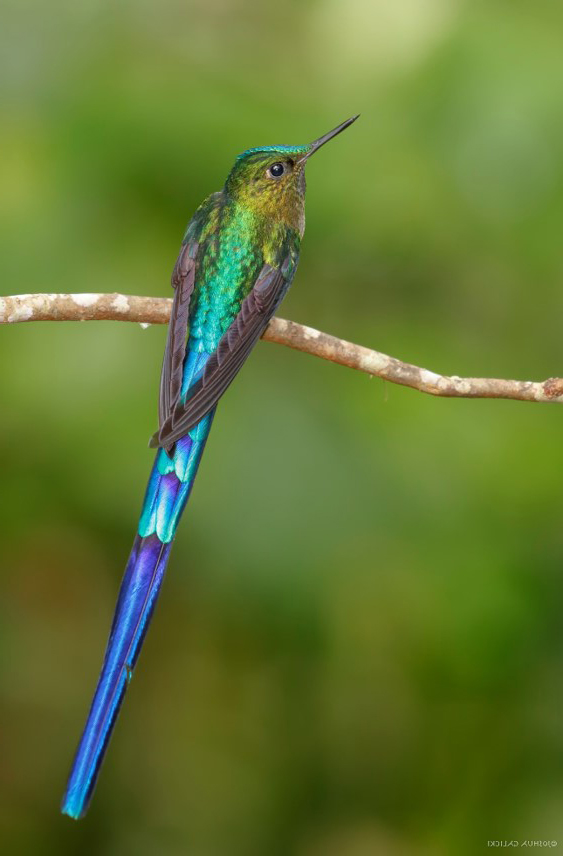
The magnificent Long-tailed Sylph will be visiting the feeders at Rio Blanco Reserve. Photo by tour participant Josh Galicki ©.
Hiking along Rio Blanco’s trails through moss and epiphyte laden cloud forest searching for mixed feeding flocks offer loads of possibilities. High on our list is Masked Saltator, which may be more easily found here than anywhere else. Past sightings also include Black-billed Mountain-Toucan, Yellow-vented Woodpecker, Dusky Piha, White-throated Quail-Dove, Striped and Flammulated Treehunters and an entire host of flycatchers, tanagers and others. Night Rio Blanco.
Day Six – Rio Blanco clean-up, Los Nevados National Park, Termales del Ruiz. We’ll have a final morning for photography and birding clean-up at Rio Blanco. With multiple mornings planned here, we’ll be able to repeat our visit to the antpitta feeders, set-up at the hummingbird feeders or meander the reserve’s trails searching for feeding flocks or shy forest birds. We’ll have until lunchtime before we must pack our bags and leave this most delightful birding & photography paradise.
After departing Rio Blanco, we drive higher into the mountains toward our hotel, Termales del Ruiz, at about 3,500 meters above sea level. Our home for two nights, we can enjoy the hotel’s mineral-rich hot springs, scenic views of the central Andes and a series of hummingbird feeders that attract a superb selection of high altitude hummingbird species. Species photographed on past visits include Sword-billed Hummingbird, Black-thighed and Golden-breasted Pufflegs, Viridian Metaltail, Rainbow-bearded Thornbill, Mountain Velvetbreast and the thoroughly impressive Great Sapphirewing. Night Termales del Ruiz.
Day Seven – Nevada del Ruiz, Laguna Negra, Termales del Ruiz. Today we will head toward our highest elevations of our Colombian adventure at Nevado del Ruiz. Following a road through patches of forest that give way to Paramo (tropical grassland above treeline), the scenery is magical, with velvety frailejon plants adding a touch of surrealism to the landscape. So foreign looking that it will remind you of a background from an original Star Trek episode! Temperatures are likely to be cold, and we’ll reach elevations upwards of 13,000 feet. Our mission? Seeking out high elevation specialists that include: Buffy Helmetcrest, Paramo Tapaculo, Rainbow-bearded Thornbill, Viridian Metaltail, Stout-billed Cinclodes, Brown-backed Chat-Tyrant, Scarlet-bellied Mountain-Tanager, Black-backed Bush-Tanager, Glossy Flowerpiercer, Andean Siskin and the endemic and quite-difficult-to-find Rufous-fronted Parakeet. We’ll concentrate our search for this retiring endemic along a short stretch of road as it passes through elfin forest. Tawny Antpittas, who are often quite tame here, will entertain us as we wait for the parakeets to make their appearance.
We’ll also bird around Laguna Negra, a picturesque glacial lake, where it’s possible to find Many-striped Canastero, White-tailed Hawk, Black-chested Buzzard-Eagle, Andean Tit-Spinetail, White-chinned Thistletail, Andean Duck, Andean Teal, Grass Wren and Pale-naped Brush-Finch. A bonus is the variety of seedeaters found in this section of Paramo grassland, including Plumbeous Sierra-Finch and Paramo and Plain-colored Seedeaters. Night Termales del Ruiz.
Day Eight – Los Nevados clean-up, to Pereira, fly to Bogota. A pre-breakfast outing for our final looks at Buffy Helmetcrest, the bizarre frailejon-covered landscape and magnificent Andean Condor. Our schedule is flexible, so we’ll have a game-time decision as to our day’s events. Time is a bit short as we’ll have to leave in the late morning in order to catch our return flights to Bogota where Rachel will join us. Night Bogota.
Day Nine – Jardin Encantado, lower portions of Chingaza National park, to Observatorio de Colibries. After a sumptuous breakfast at our hotel, we’ll begin our birding day at one of several potential sites in the area surrounding Bogota. Wherever our travels take us, El Tabacal, La Florida or La Siecha, we WILL visit a small backyard site that may prove to one of your favorites of the entire trip. El Jardin Encantado, The Enchanted Garden in Spanish, packs more than 40 hummingbird feeders into a small garden. There are so many hummingbirds, usually several hundred or more!, frantically buzzing you, each other and every single feeder that it’s difficult to decide which one to admire first! While 27 species have been recorded, we are likely to find a dozen or so in a single visit at this time of the year. Species we’re most likely to find are the endemic Indigo-capped Hummingbird, Black-throated Mango, Rufous-tailed Hummingbird, a duo of near endemics—Red-billed and Short-tailed Emeralds, White-vented Plumeleteer and Lesser (Green), Brown and Sparkling Violetears. Less common visitors include Green Hermit, Purple-crowned Fairy, Violet-crowned Woodnymph, White-necked Jacobin, Ruby-topaz Hummingbird and Lazuline Sabrewing.
Enroute to our home for the next two nights, we’re likely to search for the endangered and endemic Brown-breasted Parakeet at lower elevations within Chingaza National park. Here a somewhat different collection of birds can be found, including Amethyst-throated Sunangel, Glowing Puffleg, Blue-capped and Blue-and-black Tanagers, Black-collared Jay, Powerful Woodpecker, Ochre-breasted Brushfinch and Azara´s Spinetail.
We’ll have a late afternoon arrival at Observatorio de Colibries, a private compound in the mountains only eleven miles east of Bogota. Sitting at about 9,800 feet above sea level, Observatorio attracts a dozen or more species of hummingbirds to its intimate setting. While 18 species of hummingbirds have been recorded thus far, 12 to 15 species are more regular. Included in this group are a number species that we’re likely to see/photograph at close range—Lesser and Sparkling Violetears, Amethyst-throated Sunangel, Speckled and Sword-billed Hummingbirds, Long-tailed Sylph, Black-tailed and Green-tailed Trainbearers, Glowing and Coppery-bellied Pufflegs, Blue-throated Starfrontlet, Mountain Velvetbreast, White-bellied Woodstar and the incomparable Great Saphirewing. We’ll enjoy their antics with our binoculars and cameras until dark! Night Observatorio de Colibries.
Day Ten – Chingaza National Park, Siecha Wetlands, Observatorio de Colibries. After an early breakfast, we face east and begin our trek to the highlands of Chingaza National Park. Birds are reduced in numbers at these high altitudes, but what is missing in quantity is more than adequately compensated by QUALITY and/or RARITY! Highest on our list of targets are the endemic Green-bearded Helmetcrest and Silvery-throated Spinetail. Other possible specialties include hummingbirds like Bronze-tailed Thornbill, Coppery-bellied and Glowing Pufflegs, Amethyst-throated Sunangel, Blue-throated Starfrontlet and Great Saphirewing. High altitude species like Black-chested Buzzard-Eagle, Andean Pygmy-Owl, Black-billed Mountain-Toucan, Crimson-mantled and Powerful Woodpeckers and Ash-colored, Ocellated and Pale-bellied Tapaculos. Furnariids abound, and possibilities include White-chinned Thistletail, White-browed Spinetail, Many-striped Canastero, Agile Tit-Tyrant and a nice collection of others. Rufous-browed Conebill, White-capped Tanager, Black-headed Hemispingus, Black-chested and Scarlet-bellied Mountain Tanagers, an endemic subspecies of Golden-fronted Redstart, Ochre-breasted Brush-Finch, Mountain Cacique and Andean Siskin provide passerine highlights.
Flooded former limestone quarries near the Siecha River have resulted in a series of wetlands holding a number of target species for us. Topping the list are two endangered endemics, Bogota Rail and Apolinar’s Wren, which are now restricted to only a few high altitude wetlands. Other possible sightings here include an endemic race of Spot-flanked Gallinule, Andean Duck, Andean Teal, Noble Snipe and the endemic race of American Coot. Our midwinter visit should also give us some wintering North American birds and nomadic Colombian species.
We’ll return to Observatorio with time for additional hummingbird photography before nightfall and dinner. Night Observatorio de Colibries.
Day Eleven – Clean up near Bogota, fly to Barranquilla. We’ll have most of a morning to explore near our guesthouse. A second visit to the Siecha wetlands if we still need Bogota Rail or Noble Snipe, more time with the bustling hummingbirds on the Observatorio grounds or a chance to sleep in, repack and prepare for our early afternoon flight.
Lunch will be at the airport as we wait for our flights to Barranquilla. Once we arrive, we’ll transfer to our hotel for a leisurely evening for reviewing our checklists, editing photos or preparing for our journey in the Sierra Nevada de Santa Marta. Night Barranquilla.
Day Twelve – Isla Salamanca, Minca, El Dorado Reserve. Rising early, we’ll spend our morning birding the bird-rich coastal woodlands and wetlands of Isla Salamanca National Park. A short 15 minutes from Barranquilla, we’ll explore the park’s newly rebuilt walk-ways. Cutting through coastal mangroves, we’ll search for the endemic Saphire-throated Hummingbird, rare Chestnut Piculet, more common Bare-eyed Pigeon, Red-rumped Woodpecker, Brown-throated Parakeet, Green-and-rufous Kingfisher, Northern Scrub-Flycatcher, Venezuelan Flycatcher, Black-crested Antshrike, Bicolored Conebill, endemic form of Bronzed Cowbird—the Bronze-brown Cowbird—and Yellow-chinned Spinetail among many others.
After a morning of birding we’ll embark on our 2-hour drive to Minca. Coastal wetlands we’ll pass through along the way may offer Fulvous Whistling-Duck, Black-bellied Whistling-Duck, Cinnamon Teal, White-cheeked Pintail, Black-necked Stilt, wintering sandpipers, gulls and terns, Black-collared Hawk, Glossy Ibis, Roseate Spoonbill, Pied Water-Tyrant and White-headed MarshTyrant as we search for the striking Northern Screamer. Restricted to marshy lowlands in northern Colombia and extreme northwestern Venezuela, we often find them perched atop taller vegetation within these wetlands.
A quaint little town along a quiet river amid the Sierra Nevada de Santa Marta foothills, Minca is a great birding location for lower elevation species. We’ll arrive with time to visit some hummingbird feeders during lunch. Expected species include Rufous-breasted Hermit, Black-throated Mango, Long-billed Starthroat, Santa Marta Woodstar, Red-billed Emerald and Violet-crowned Woodnymph. We’ll take a bit of time to explore surrounding areas in search of local goodies such as Black-backed Antshrike, Rufous-tailed Jacamar, Keel-billed Toucan, Masked Tityra and Whooping Motmot before beginning our climb to the El Dorado Bird Reserve.
As we bird our way uphill toward the El Dorado Lodge, we’ll search for skulking Santa Marta Foliage-gleaner, elegant Swallow Tanager (another Santa Marta endemic subspecies), new hummingbirds like Coppery Emerald, Blossomcrown and Santa Marta Woodstar (both endemic), Santa Marta and Yellow-billed Toucanets, Pale-breasted Spinetail, Streaked Xenops, Cocoa Woodcreeper, endemic Santa Marta Tapaculo, Venezuelan Tyrannulet, Orange-billed NightingaleThrush and White-lored Warbler, another endemic.
After getting settled into our rooms, we’ll explore the grounds, overlooks and feeders of El Dorado Lodge. Night El Dorado Bird Reserve.
Day Thirteen – El Dorado Lodge & Reserve, San Lorenzo Ridge, Cerro Kennedy. Another early morning finds us heading up to higher elevations of the Sierra Nevada de Santa Marta towards Cerro Kennedy. Our pre-dawn departure should find us atop the San Lorenzo Ridge at sunrise. Arriving early allows us to watch the landscape come alive as birds begin their day. A primary target are the small flocks of endangered Santa Marta Parakeets that are most easily found here at dawn. Our primary goal for the day is to find range-restricted endemics like Santa Marta Parakeet, Santa Marta Warbler, Santa Marta Mountain-Tanager, Santa Marta Bush-Tyrant, Brown-rumped Tapaculo and Red-crested Cotinga, among many others. We’ll have a picnic at high elevation with great views of the Sierra Nevada de Santa Marta. After lunch, we’ll bird along the road on our way down hoping to run into awe inspiring species such as Swallow Tanager, Grove-billed and Santa Marta Toucanet, Black-chested Jay, White-bellied Antbird and the near endemic White-tipped Quetzal. After dinner we’ll have an after dark outing to search for the recently described endemic Santa Marta Screech-Owl. Night El Dorado Bird Reserve.
Day Fourteen – El Dorado Lodge & Reserve. After breakfast we will have time to enjoy the well-maintained feeders at the lodge. Hummingbirds that visit the feeders include the endemic White-tailed Starfrontlet, Black-backed Thornbill, a Santa Marta endemic race, and future split, of Tyrian Metaltail, White-vented Plumeleteer and Long-tailed Hermit. The lodges gardens with its many banana plants and colorful flowers attract endemic Santa Marta and Colombian Brushfinches and spritely White-sided and Black Flowerpiercers. We’ll spend some time trying to see Santa Marta Antpitta. While still a skulker, like most members of that family, they are comparatively bold for an antpitta. We often find them hopping leisurely along the forest floor or coming to forest edges searching for food. A day of birding near the lodge has many rewards, with a special treat being the near endemic Black-fronted Wood-quail that often visits the lodge’s forest-edge compost pile in the late afternoon. Night El Dorado Bird Reserve.
Day Fifteen – El Dorado Lodge & Reserve, to Barranquilla. We’ll spend our final morning birding around the lodge in search of any targets we may have missed. We’ll be able to do the same as we retrace our path down the mountain toward Barranquilla, so we’ll have another chance at Santa Marta Foliage-gleaner, Blossomcrown, Santa Marta Woodstar or any others we may have missed on our way up. Our schedule is wide open, giving us ample time to search for any missing specialties or target species. We’ll arrive back into Barranquilla in the late afternoon/early evening with plenty of time to clean-up for our final evening together in Colombia. Night Barranquilla
Day Sixteen – Morning flights home. As morning flights are planned, there are no group activities for today. If departure times allow, you’ll eat breakfast at the hotel before transferring to the airport for your return flights. As you travel, you can review our travels in your mind’s eye, double-check lifers on your birdlist and edit a few of your photos. All wonderful ways to relive your experiences of our time in Colombia, the ultimate birding destination!
Tour Information and Pricing
| Registration |
